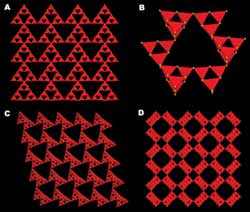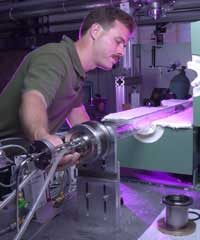Materials Sciences
Materials management deals with the research, development, manufacturing and processing of raw and industrial materials. Key aspects here are biological and medical issues, which play an increasingly important role in this field.
innovations-report offers in-depth articles related to the development and application of materials and the structure and properties of new materials.

Electronic Circuit Rides a Chemical Film
Chains of molecules known as conducting polymers are versatile materials that can work like electronic circuits. Potential uses include flat panel displays, solar panels, sensing devices and transistors, to name just a few. Their invention won three scientists the Nobel Prize in chemistry.
But to make useful devices from conducting polymers requires a degree of chemical wizardry that often proves elusive. University of Illinois at Chicago chemistry professor Luke Hanley has found a new and

UC Riverside scientists synthesize new porous materials
New materials will have applications in electronic and optoelectronic devices, electrocatalysis, electroanalysis and sensors
Scientists at the University of California, Riverside have synthesized a large family of semiconducting porous materials that have an unprecedented and diverse chemical composition.
The new materials show several different properties such as photoluminescence, ion exchange, and gas sorption. They also have a large surface area and uniform pore sizes. I

Jefferson Lab’s Free-Electron Laser explores promise of carbon nanotubes
Jefferson Lab’s Free-Electron Laser used to explore the fundamental science of how and why nanotubes form, paying close attention to the atomic and molecular details
Scientists and technologists of all stripes are working intensively to explore the possibilities of an extremely strong and versatile cylinder so tiny that millions — which in bunches look like an ebony snowflake — could fit easily on the tip of a pin. The objects in question are known as carbon nanotubes, first discov

Singing Concrete
Physicists from the St. Petersburg State Institute of Technology have invented an unusual method for improving concrete. The researchers believe that the concrete structure will become more uniform, and concrete products will obtain unprecedented durability and water-resistance if, while hardening, concrete is exposed to the influence of electromagnetic field of a strictly determined frequency.
The actual process is as follows: the concrete blocks while they are still in the mould ar

Computer program reveals optimum microstructure for new materials
Technique could help bring efficiency of biology to man-made materials
A Princeton chemist has developed a general mathematical system for designing materials that perform two functions at once, even when the desired properties sometimes conflict with each other.
Salvatore Torquato and colleagues used computers to calculate the optimum structure for any material that is a composite of two substances with differing properties. The achievement is the first simple example of a

The possibility of reducing monomer residues in polymers
POLYMAT, the University of the Basque Country’s Institute of Polymer Materials, is helping to solve the problem of contamination of polymers obtained through polymerisation processes involving emulsions. With European funding obtained four years ago, the project on removing monomer residues from polymers was undertaken. POLYMAT has been working in this field with the collaboration of three other universities (from Germany, Greece and Switzerland) as well as three foreign companies.
Unfortun